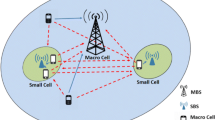Abstract
We study power control in optimization and game frameworks. In the optimization framework there is a single decision maker who assigns network resources and in the game framework users share the network resources according to Nash equilibrium. The solution of these problems is based on so-called water-filling technique, which in turn uses bisection method for solution of non-linear equations for Lagrange multipliers. Here we provide a closed form solution to the water-filling problem, which allows us to solve it in a finite number of operations. Also, we produce a closed form solution for the Nash equilibrium in symmetric Gaussian interference game with an arbitrary number of users. Even though the game is symmetric, there is an intrinsic hierarchical structure induced by the quantity of the resources available to the users. We use this hierarchical structure to perform a successive reduction of the game. In addition to its mathematical beauty, the explicit solution allows one to study limiting cases when the crosstalk coefficient is either small or large. We provide an alternative simple proof of the convergence of the Iterative Water Filling Algorithm. Furthermore, it turns out that the convergence of Iterative Water Filling Algorithm slows down when the crosstalk coefficient is large. Using the closed form solution, we can avoid this problem. Finally, we compare the non-cooperative approach with the cooperative approach and show that the non-cooperative approach results in a more fair resource distribution.
Similar content being viewed by others
Explore related subjects
Discover the latest articles, news and stories from top researchers in related subjects.References
Altman, E., Avrachenkov, K., & Garnaev, A. (2007). A jamming game in wireless networks with transmission cost. In Lecture notes in computer science: Vol. 4465. Proceedings of NET-COOP 2007 (pp. 1–12).
Altman, E., Avrachenkov, K., Miller, G., & Prabhu, B. (2007). Discrete power control: cooperative and non-cooperative optimization. In Proceedings of IEEE INFOCOM 2007. An extended version is available as INRIA research report no. 5818.
Cover, T., & Thomas, J. (1991). Elements of information theory. New York: Wiley.
Heinzelman, W. R., Chandrakasan, A., & Balakrishnan, H. (2000). Energy-efficient communication protocol for wireless microsensor networks. In Proceedings of the 33rd annual Hawaii international conference on system sciences (Vol. 2), Jan. 2000.
Garnaev, A. (2000). Search games and other applications of game theory. Berlin: Springer.
Goldsmith, A. J., & Varaiya, P. P. (1997). Capacity of fading channels with channel side information. IEEE Transactions on Information Theory, 43(6), 1986–1992.
Kwon, T. J., & Gerla, M. (1999). Clustering with power control. In Proceedings of IEEE military communications conference (MILCOM’ 99) (Vol. 2, pp. 1424–1428). Atlantic City, NJ, USA, 1999.
Lai, L., & El Gamal, H. (2006). Fading multiple access channels: a game theoretic perspective. In IEEE international symposium on information theory (ISIT) (pp. 1334–1338). Seattle, WA, July 2006.
Lin, C. R., & Gerla, M. (1997). Adaptive clustering for mobile wireless networks. IEEE Journal on Selected Areas in Communications, 15(7), 1265–1275.
Luo, Z.-Q., & Pang, J.-S. (2006). Analysis of iterative water-filling algorithm for multiuser power control in digital subscriber lines. EURASIP Journal on Applied Signal Processing, 2006, 10.
Popescu, O., & Rose, C. (2003). Water filling may not good neighbors make. In Proceedings of GLOBECOM 2003 (Vol. 3, pp. 1766–1770).
Popescu, D. C., Popescu, O., & Rose, C. (2004). Interference avoidance versus iterative water filling in multiaccess vector channels. In Proceedings of IEEE VTC 2004 Fall (Vol. 3, pp. 2058–2062).
Song, K. B., Chung, S. T., Ginis, G., & Cioffi, J. M. (2002). Dynamic spectrum management for next-generation DSL systems. IEEE Communications Magazine, 40, 101–109.
Tse, D., & Viswanath, P. (2005). Fundamentals of wireless communication. Cambridge: Cambridge University Press.
Yu, W. (2002). Competition and cooperation in multi-user communication environements. PhD thesis, Stanford University, June 2002.
Yu, W., Ginis, G., & Cioffi, J. M. (2002). Distributed multiuser power control for digital subscriber lines. IEEE Journal on Selected Areas in Communications, 20, 1105–1115.
Author information
Authors and Affiliations
Corresponding author
Additional information
The work was partly supported by EGIDE ECO-NET Grant no. 18933SL and RFBR Grant no. 09-01-00334-a.
Rights and permissions
About this article
Cite this article
Altman, E., Avrachenkov, K. & Garnaev, A. Closed form solutions for water-filling problems in optimization and game frameworks. Telecommun Syst 47, 153–164 (2011). https://doi.org/10.1007/s11235-010-9308-0
Published:
Issue Date:
DOI: https://doi.org/10.1007/s11235-010-9308-0




